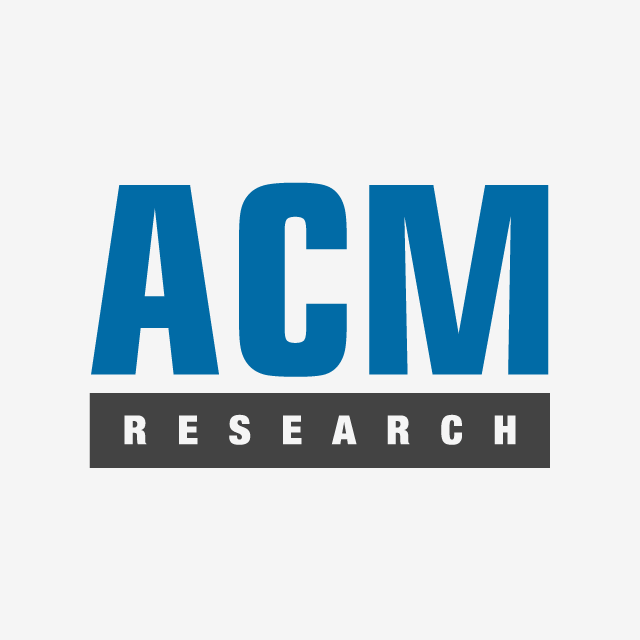Company Analysis ACM Research
1. Summary
Advantages
- Price (15.21 $) is less than fair price (23.67 $)
- The stock's return over the last year (-2%) is higher than the sector average (-33.27%).
Disadvantages
- Dividends (0%) are below the sector average (0.6669%).
- Current debt level 6.36% has increased over 5 years from 6.32%.
- The company's current efficiency (ROE=10.08%) is lower than the sector average (ROE=16.8%)
Similar companies
2. Share price and performance
2.1. Share price
2.2. News
2.3. Market efficiency
| ACM Research | Technology | Index | |
|---|---|---|---|
| 7 days | 5.4% | 0.2% | -1.9% |
| 90 days | -4.7% | -34.4% | 2.7% |
| 1 year | -2% | -33.3% | 26.1% |
ACMR vs Sector: ACM Research has outperformed the "Technology" sector by 31.27% over the past year.
ACMR vs Market: ACM Research has significantly underperformed the market by -28.08% over the past year.
Stable price: ACMR is not significantly more volatile than the rest of the market on "NASDAQ" over the last 3 months, with typical variations of +/- 5% per week.
Long period: ACMR with weekly volatility of -0.0385% over the past year.
3. Summary of the report
4. Fundamental Analysis
4.1. Stock price and price forecast
Below fair price: The current price (15.21 $) is lower than the fair price (23.67 $).
Price significantly below the fair price: The current price (15.21 $) is 55.6% lower than the fair price.
4.2. P/E
P/E vs Sector: The company's P/E (15.53) is lower than that of the sector as a whole (76.39).
P/E vs Market: The company's P/E (15.53) is lower than that of the market as a whole (51.48).
4.2.1 P/E Similar companies
4.3. P/BV
P/BV vs Sector: The company's P/BV (1.29) is lower than that of the sector as a whole (9.3).
P/BV vs Market: The company's P/BV (1.29) is lower than that of the market as a whole (3.44).
4.3.1 P/BV Similar companies
4.4. P/S
P/S vs Sector: The company's P/S indicator (2.15) is lower than that of the sector as a whole (8.3).
P/S vs Market: The company's P/S indicator (2.15) is lower than that of the market as a whole (10.3).
4.4.1 P/S Similar companies
4.5. EV/Ebitda
EV/Ebitda vs Sector: The company's EV/Ebitda (10.75) is lower than that of the sector as a whole (121.82).
EV/Ebitda vs Market: The company's EV/Ebitda (10.75) is lower than that of the market as a whole (29.6).
5. Profitability
5.1. Profitability and revenue
5.2. Earnings per share - EPS
5.3. Past profitability Net Income
Yield Trend: Rising and has grown by 62.29% over the last 5 years.
Earnings Slowdown: The last year's return (0%) is below the 5-year average return (62.29%).
Profitability vs Sector: The return for the last year (0%) exceeds the return for the sector (-14.23%).
5.4. ROE
ROE vs Sector: The company's ROE (10.08%) is lower than that of the sector as a whole (16.8%).
ROE vs Market: The company's ROE (10.08%) is higher than that of the market as a whole (8.95%).
5.5. ROA
ROA vs Sector: The company's ROA (5.19%) is lower than that of the sector as a whole (9.13%).
ROA vs Market: The company's ROA (5.19%) is lower than that of the market as a whole (6.3%).
5.6. ROIC
ROIC vs Sector: The company's ROIC (5.64%) is lower than that of the sector as a whole (13.26%).
ROIC vs Market: The company's ROIC (5.64%) is lower than that of the market as a whole (10.79%).
7. Dividends
7.1. Dividend yield vs Market
Low yield: The dividend yield of the company 0% is below the average for the sector '0.6669%.
7.2. Stability and increase in payments
Unstable dividends: The company's dividend yield 0% has not been consistently paid over the past 7 years, DSI=0.
Weak dividend growth: The company's dividend yield 0% has been growing weakly or stagnant over the past 5 years. Growth over only 0 years.
7.3. Payout percentage
Dividend Coverage: Current payments from income (5.11%) are at an uncomfortable level.
8. Insider trades
8.1. Insider trading
Insider Buying Exceeds insider sales by 59.47% over the last 3 months.
8.2. Latest transactions
| Transaction date | Insider | Type | Price | Volume | Quantity |
|---|---|---|---|---|---|
| 06.02.2025 | McKechnie Mark See Remarks |
Sale | 22 | 330 000 | 15 000 |
| 06.02.2025 | McKechnie Mark See Remarks |
Purchase | 5.6 | 84 000 | 15 000 |
| 06.02.2025 | MARK A MCKECHNIE Officer |
Purchase | 22 | 330 000 | 15 000 |
| 06.02.2025 | SOTHEARA CHEAV Officer |
Purchase | 23 | 519 754 | 22 598 |
| 29.11.2024 | HAIPING DUN Director |
Purchase | 17.43 | 332 181 | 19 058 |
Pay for your subscription
More functionality and data for company and portfolio analysis is available by subscription




